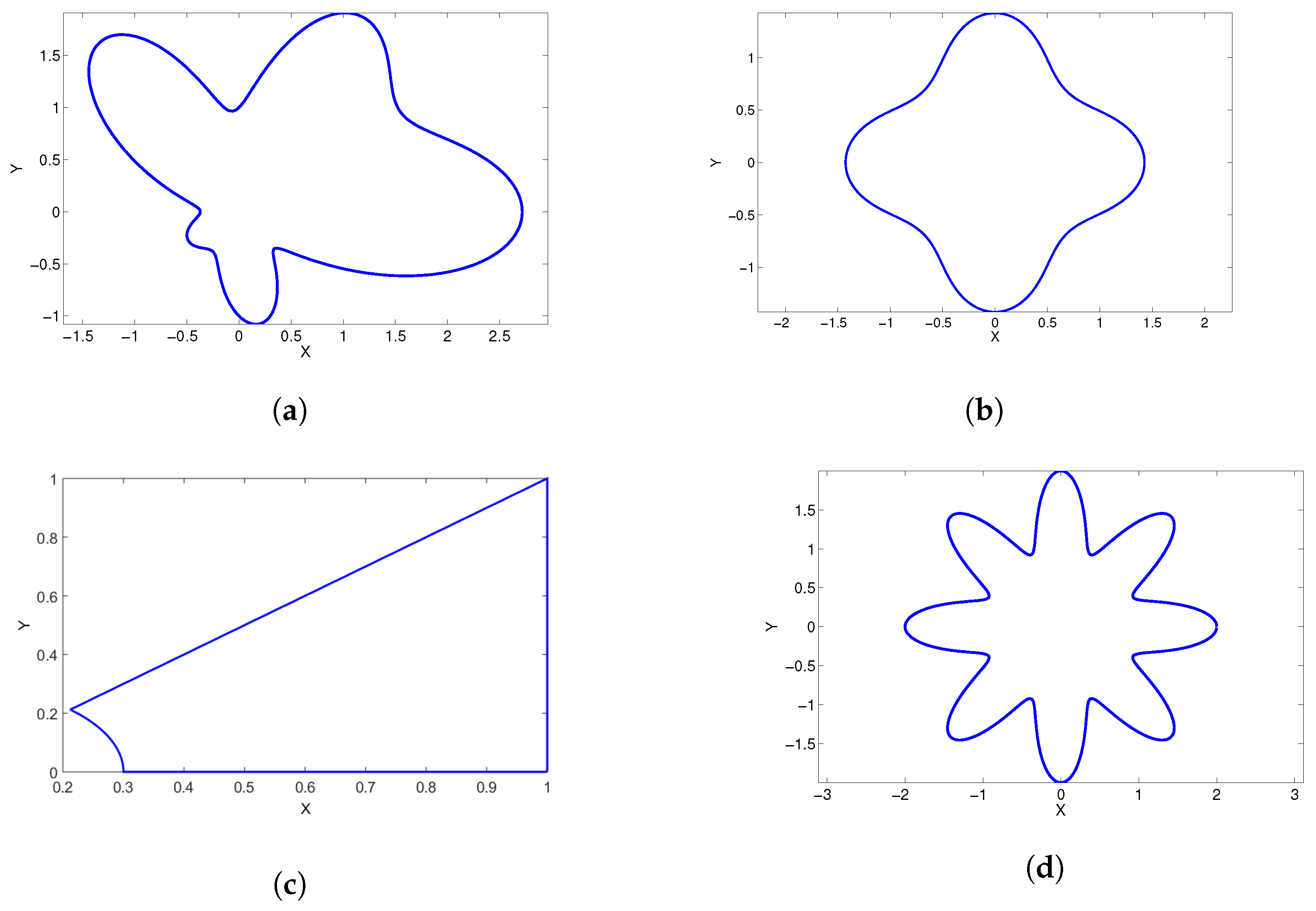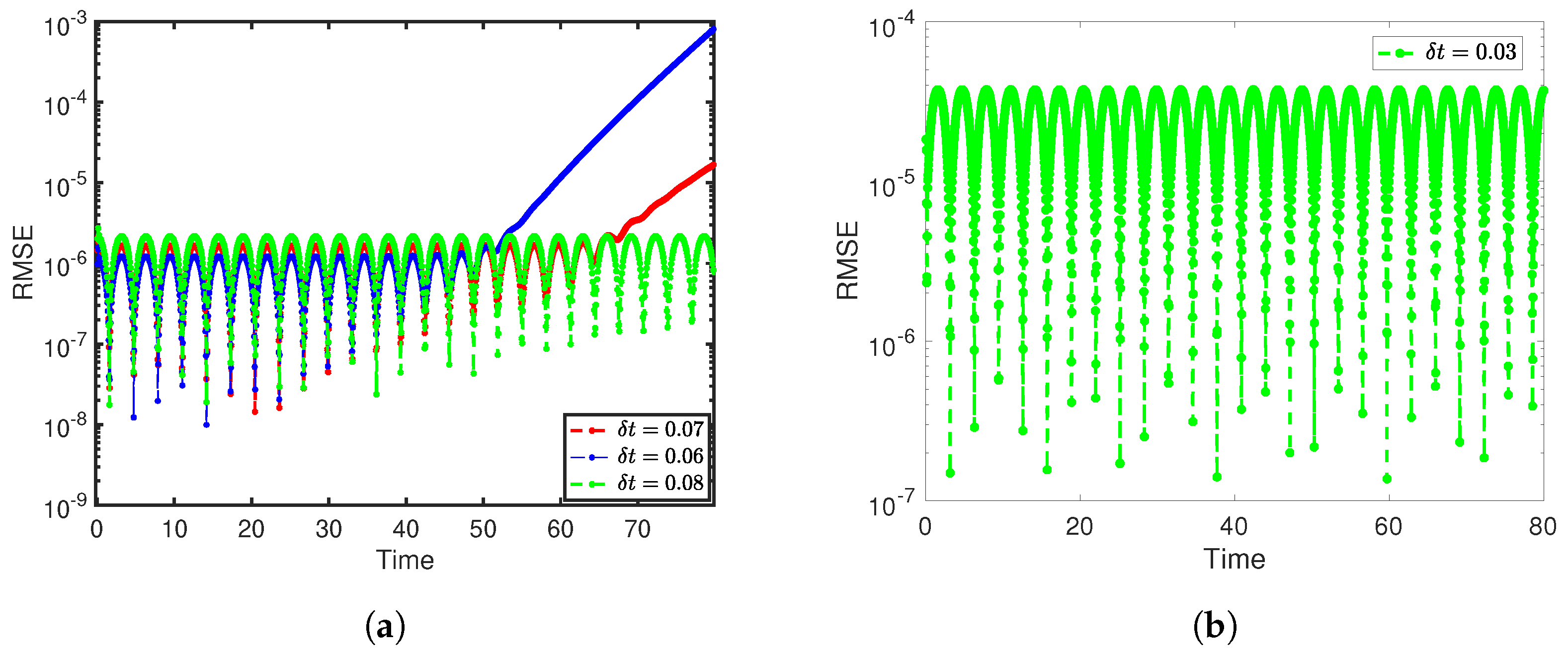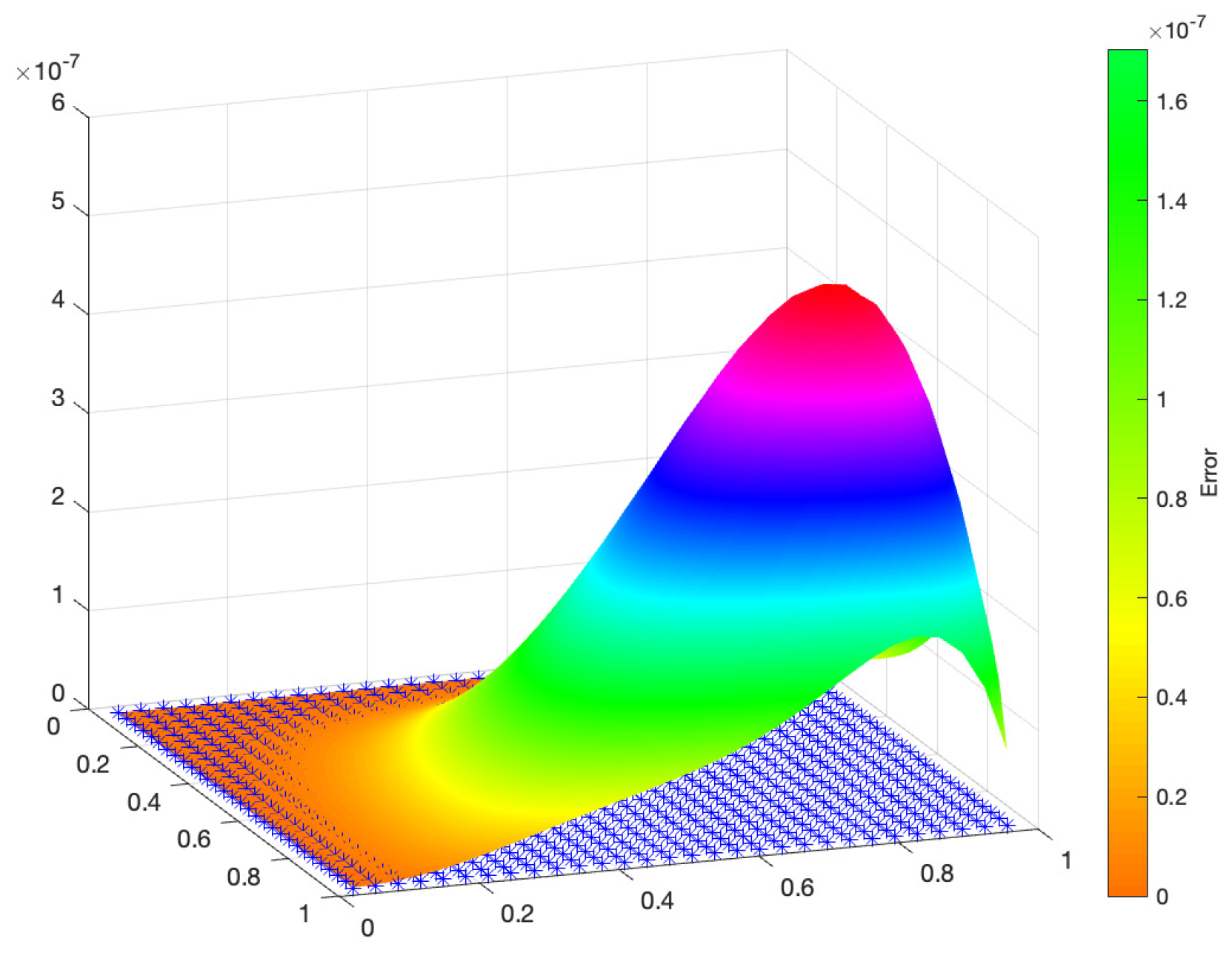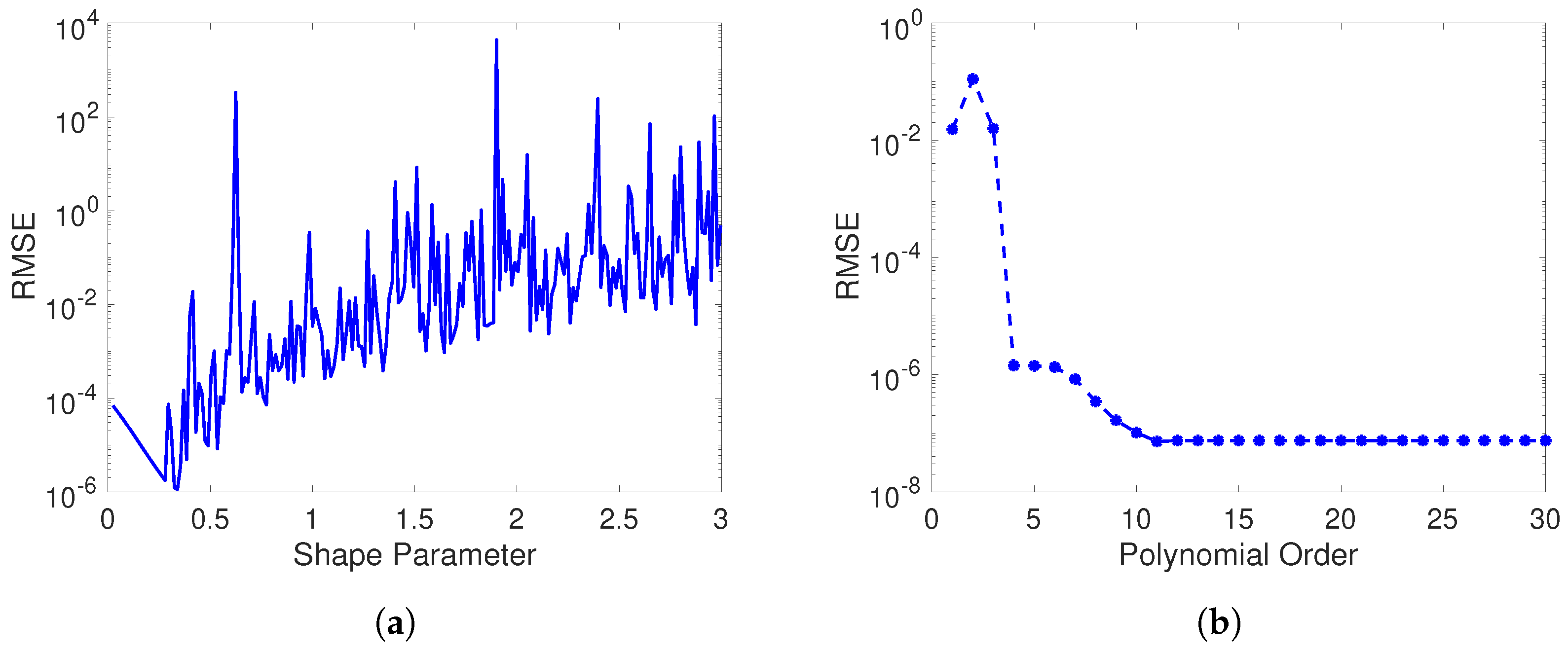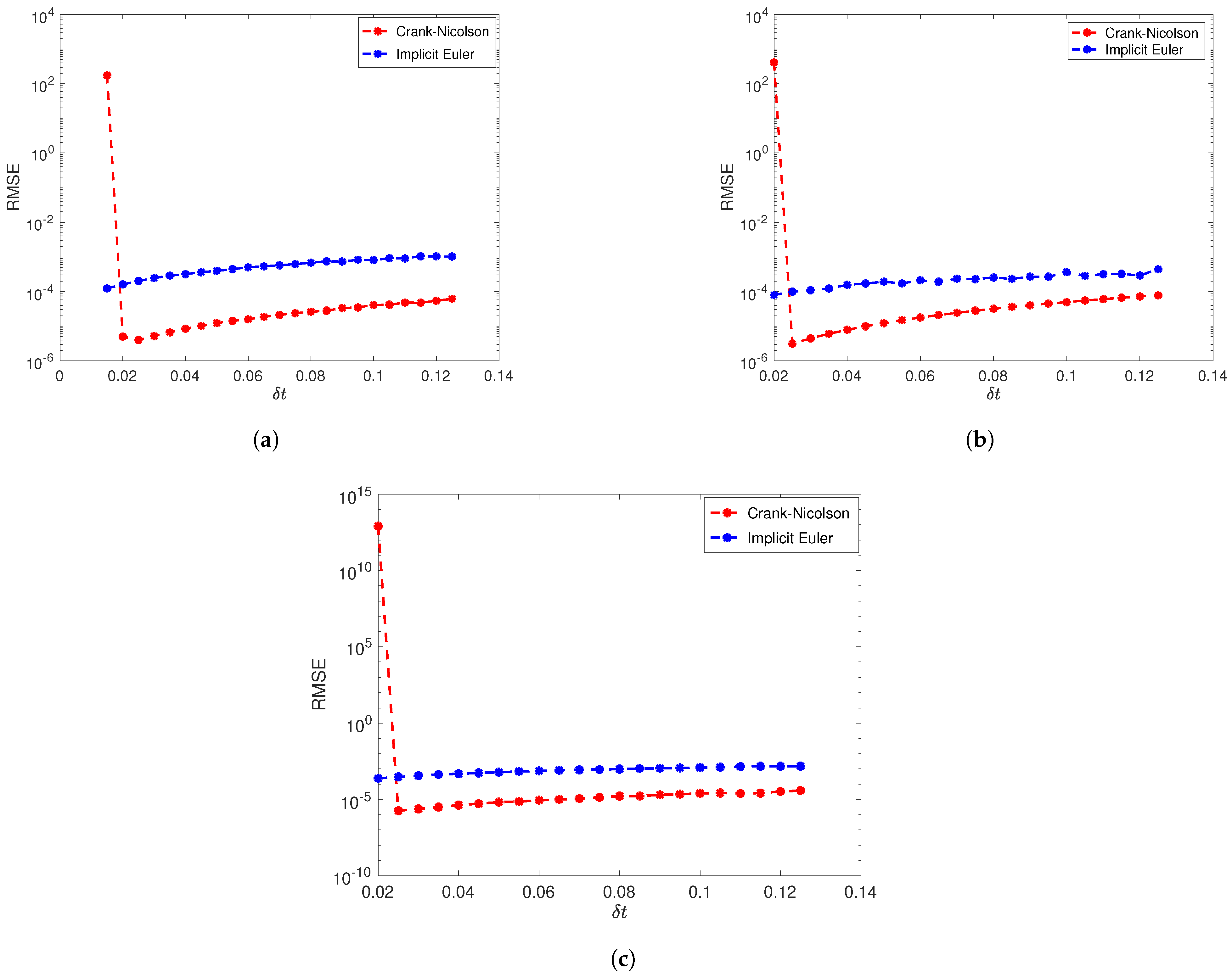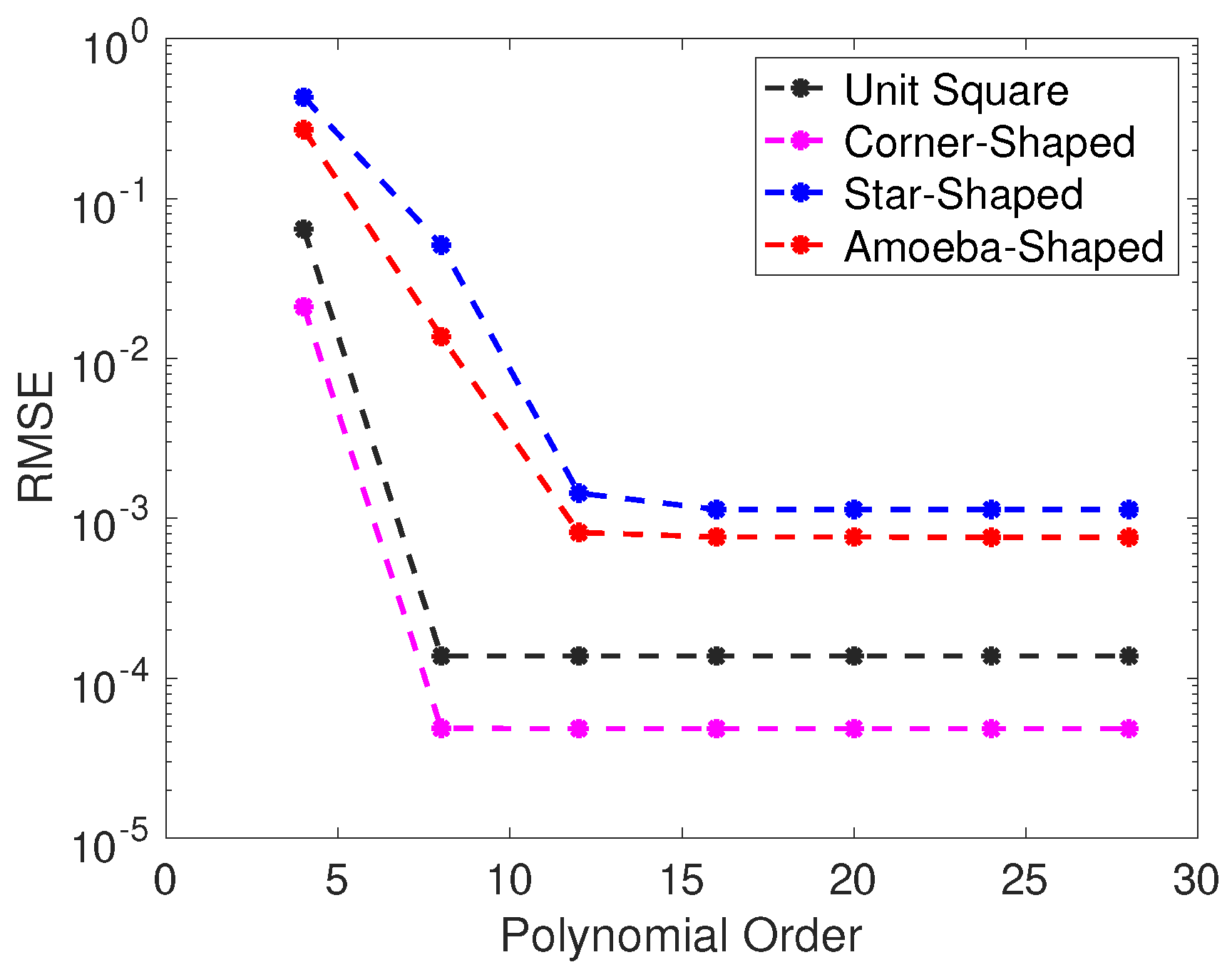Example 1. In this example, we solve the Schrödinger Equations (1)–(3) with the potential function,where and g are given based on the following analytical solution: We first chose
interior nodes and
boundary nodes on a corner-shaped (
Figure 1c) computational domain. The Crank–Nicolson scheme was applied for temporal discretization with a time step of
and a terminal time of
for this experiment.
Figure 2a illustrates the effect of the multiple-scale technique which significantly reduced the condition number of the resultant matrix. The multiple-scale technique played a crucial role in achieving highly accurate and stable results, particularly as the order of polynomial basis functions increased. As shown in
Figure 2b, the accuracy of the method improved from 1 × 10
−2 to 1 × 10
−7 with the implementation of the multiple-scale technique.
Furthermore, we performed a comparison between two temporal discretization techniques, the backward Euler method and the Crank–Nicolson method, on a unit square domain to verify the effectiveness of our method. We compared the RMSE of the real parts of the solution for both methods in which the computational domain consisted of
interior nodes and
boundary nodes. We selected a time step of
, polynomial basis functions of the order 13, and a terminal time
for this experiment. As shown in
Figure 3, both methods yielded stable and highly accurate solutions over the time interval
. The comparison clearly demonstrates the effectiveness of the proposed method.
The numerical accuracy of the collocation methods using radial basis functions such as multiquadric functions (
) heavily depends on the shape parameter
c. However, we do not need a shape parameter for the MPS-PBF. The comparison of the numerical accuracy between the RBF collocation method and MPS-PBF is presented in
Table 1. The numerical results for the multiquadric (MQ) radial basis function are taken from the article by Dehghan et al. [
10]. In this comparison, polynomial basis functions of the order 13 were employed with the time step
chosen on a unit square domain. The results clearly indicate that the MPS-PBF provided significantly more accurate solutions than the MQ RBF at various terminal times,
. An important advantage of the MPS-PBF is that it avoids the use of an indeterminant shape parameter, which is a major challenge in many RBF collocation methods.
Next, we present the numerical accuracy of the proposed method with different time steps.
Table 2 presents a comparison of the error estimate for the real and imaginary parts of the solution to the given problem, evaluated for various time steps using the backward Euler method and Crank–Nicolson method. The numerical results in the table clearly demonstrate that both methods are very stable and highly accurate.
Additionally, we investigated the performance of our method for various terminal times, ranging from
to
The numerical results presented in
Table 3 further confirm that both the backward Euler method and Crank–Nicolson method yielded highly accurate and stable results across the different terminal times.
Figure 4a displays the RMSE versus terminal time for different time steps (
, 0.07, 0.08) using the Crank–Nicolson method. In this method, larger time steps were generally required to achieve better accuracy for higher terminal times. However, accuracy began to deteriorate beyond a certain terminal time, as depicted in the
Figure 4a. On the other hand,
Figure 4b exhibits the RMSE versus terminal time for a fixed time step,
, and terminal time,
, using the backward Euler method. Unlike the Crank–Nicolson method, the backward Euler method provided stable numerical results even with smaller time steps, maintaining accuracy for higher terminal times. From the
Figure 4, we observe that both methods produced highly accurate numerical results but the Crank–Nicolson method demonstrated superior numerical accuracy compared to the backward Euler method.
Figure 5 illustrates the absolute value error distribution on the surface of the domain, while
Figure 6 displays the approximate and exact solutions for the real part of the solution. This experiment was conducted using the Crank–Nicolson method with a time step of
and a terminal time of
The computational domain consisted of 900 interior nodes and 236 boundary nodes. From
Figure 5, we observe that error was maximized in regions where the solution exhibited a higher gradient which aligned with our expectations.
Now, we describe how we solved this equation for the imaginary part of the solution on a unit square domain using an MPS based on multiquadric radial basis function (MPS-RBF) and polynomial basis functions (MPS-PBF). The numbers of interior nodes and boundary nodes were 529 and 96 respectively. For the discretization of the time derivative, we used the Crank–Nicolson scheme with
and the terminal time
Figure 7 shows the profile of the RMSE versus the shape parameter (
Figure 7a) and the RMSE versus the order of the polynomial basis functions (
Figure 7b) using the MPS-RBF and MPS-PBF, respectively. We clearly observe that the accuracy of the numerical solution in the MPS-RBF method was highly sensitive to the choice of the shape parameter. In contrast, the accuracy of the MPS-PBF method became stable after a certain order of polynomial basis functions. Additionally, the MPS-PBF method consistently produced more accurate results than the MPS-RBF method which is consistent with the findings reported in the existing MPS-PBF literature.
Example 2. Next, we consider the problem (1)–(3) with the potential function and g are given based on the following analytical solution: Figure 8 displays the exact and approximate values for the real and imaginary parts of the complex solutions on the amoeba-shaped domain (
Figure 1a). This experiment was performed at the time
with a time step of
, using polynomial basis functions of the order 19. The Crank–Nicolson scheme was employed for temporal discretization, and the experiment was carried out with the numbers of interior and boundary nodes
and
, respectively.
Figure 9a–c present the effect of temporal discretization at different terminal times using the Crank–Nicolson and backward Euler schemes. The problem was solved on the unit square domain with
and
taking polynomial basis functions of the order 13. The RMSE in these figures was computed for real parts of the solution of the given problem. We clearly notice that Crank–Nicolson scheme worked better than the backward Euler scheme with this numerical method. We also observe that the backward Euler method was suitable for smaller time steps whereas Crank–Nicolson scheme required relatively larger time steps.
Additionally, we tested the numerical stability of our proposed method by introducing normally distributed noises at both interior and boundary nodes with varying standard deviations. A Cassini-shaped domain was considered for this experiment with
interior nodes and
boundary nodes. Polynomial basis functions of the order 13 were employed to perform this experiment.
Table 4 demonstrates the numerical accuracy of our algorithm for real parts of the solutions using the backward Euler scheme after introducing noises. Similarly,
Table 5 shows the accuracy of our algorithm for the imaginary parts of the solutions when the Crank–Nicolson scheme was used under the same conditions. From these observations, we conclude that our numerical method is highly stable for solving the time-dependent Schrödinger equation.
This experiment was performed on a unit square domain with
interior nodes and
boundary nodes. Polynomial basis functions of orders up to 10 was sufficient to achieve an accuracy of
. The accuracy of the method using both temporal discretization techniques was reported at various terminal times for the real and imaginary parts of the solutions. The time step was set to
Figure 10 clearly shows that the method produced highly accurate numerical results for both the real and imaginary parts of the solutions. Notably, the Crank–Nicolson scheme yielded slightly higher numerical accuracy than the backward Euler method, consistently with our previous examples.
Next, we solved this problem on a Cassini-shaped domain using uniform and randomly selected (non-uniform) collocation points. The numbers of interior and boundary nodes were set to
and
, respectively, and the Crank–Nicolson method was used for the temporal discretization. We successfully solved the problem and the accuracy of the method was tested with various time steps using uniform and non-uniform distributions of collocation nodes. From
Table 6, we clearly observe that our numerical method exhibited minimal sensitivity on the distributions of the collocation nodes in this experiment.
Now, we describe how we tested our numerical method on four different computational domains—a unit square, a corner-shaped domain, a star-shaped domain, and an amoeba-shaped domain—using the Crank–Nicolson method. The interior and boundary nodes for this experiment were taken to be
and
, respectively.
Figure 12 displays the RMSE versus polynomial order for the different computational domains. From this figure, we clearly observe that the solution converged once the order of the basis functions exceeded 10 and remained stable thereafter. In most of our experiments, a polynomial basis function of the order 13 provided sufficient accuracy while solving the time-dependent Schrödinger equation.
Example 4. Finally, we solved the Schrödinger Equations (1)–(4) with mixed boundary conditions. Here, the potential function for this problem was For this experiment, we chose an irregular domain (
Figure 13) with the Neumann boundary condition imposed on the part of the boundary in the fourth quadrant.
Figure 14 displays the profile of the RMSE versus the time step for the terminal time
using the MPS-PBF method.
The interior and boundary nodes were 545 and 150, respectively. The Dirichlet boundary condition was applied on 116 nodes and the Neumann boundary condition was applied on 34 nodes. We observe that our proposed method provided the best results for a time step size of for the terminal time .
Next,
Table 7 presents the numerical results for various terminal times
. It is evident from the table that our proposed method performed well with both temporal discretization techniques, yielding acceptable results for the Schrödinger equation with mixed boundary conditions.
